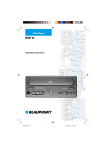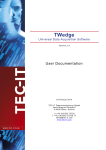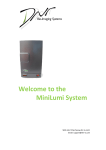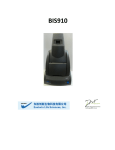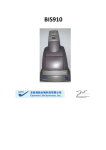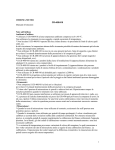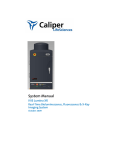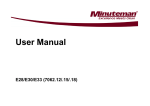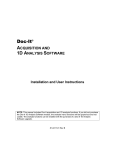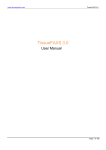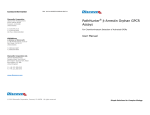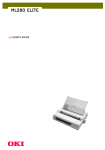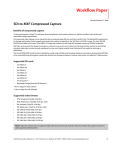Download Welcome to the MicroChemi System
Transcript
Welcome to the MicroChemi System Important Notice © Copyright 2009, DNR Bio-Imaging Systems, Ltd. All rights reserved. MicroChemi is proprietary of DNR Bio-Imaging Systems, Ltd. The information contained in this document is proprietary and is subject to all relevant copyright, patent, and other laws protecting intellectual property, as well as any specific agreement protecting DNR Bio-Imaging Systems, Ltd. (DNR) rights in the aforesaid information. Neither this document nor the information contained herein may be published, reproduced, or disclosed to third parties, in whole or in part, without the express, prior written permission of DNR. Such information is supplied solely for the purpose of assisting explicitly and properly authorized users of the MicroChemi. DNR reserves the right, without prior notice or liability, to make changes in equipment design or specifications. The text and graphics are for the purpose of illustration and reference only. The specifications on which they are based are subject to change without notice. Information in this user guide is subject to change without notice. Corporate and individual names and data used in examples herein are fictitious unless otherwise noted. The software described in this user guide is furnished under license. The software may be used or copied only in accordance with the terms of that agreement. Other company and brand products are trademarks or registered trademarks of their respective holders. This document may contain flaws, omissions, or typesetting errors; no warranty is granted nor liability assumed in relation thereto unless specifically undertaken by DNR sales, contract, or order confirmation. Information contained herein is periodically updated and changes will be incorporated into subsequent editions. If you have encountered any error please contact DNR. Contact us at: +972-2-570-0818 USA Toll-free number: 1-866-300-4286 Email: [email protected] Table of Contents 1 Introduction ............................................................................................................................................. 4 2 Overview ................................................................................................................................................. 5 System Overview .............................................................................................................................................. 5 Features and Benefits ....................................................................................................................................... 6 The MicroChemi Unit ........................................................................................................................................ 6 The MicroChemi Body .......................................................................................................................................... 6 Drawer Tray ......................................................................................................................................................... 7 GelCapture ........................................................................................................................................................ 8 Application Features ............................................................................................................................................ 9 Icons ................................................................................................................................................................... 10 3 Setup and Installation ............................................................................................................................ 11 Safety Requirements....................................................................................................................................... 11 Electrical Ratings ............................................................................................................................................. 11 Out of the Box................................................................................................................................................. 11 Hardware Setup .............................................................................................................................................. 12 Software Installation....................................................................................................................................... 12 Installing GelCapture from CD (Windows XP Pro) .............................................................................................. 13 Installing GelCapture from CD (Windows 7 Professional) .................................................................................. 17 Installing the Camera Drivers (Windows XP Pro) ............................................................................................... 23 Installing the Camera Drivers (Windows 7 Professional) ................................................................................... 26 Camera Calibration ......................................................................................................................................... 35 Calibrating the Camera from GelCapture’s Menu bar ....................................................................................... 38 4 Operating Instructions ........................................................................................................................... 39 Turning the MicroChemi Unit On .................................................................................................................... 39 Turning the MicroChemi Camera On ............................................................................................................... 40 Inserting a Sample .......................................................................................................................................... 40 Previewing an Image ....................................................................................................................................... 41 Capturing Images ............................................................................................................................................ 43 Exposure Time .................................................................................................................................................... 43 Automatic Exposure Time .................................................................................................................................. 44 Binning – Resolution vs. Sensitivity .................................................................................................................... 46 Capture Type – Single Image and Image Series ................................................................................................. 48 Saving Features ............................................................................................................................................... 55 To Save an Image ............................................................................................................................................... 55 Saving Options ................................................................................................................................................... 56 Save Image with Reference ................................................................................................................................ 56 Open an Image ................................................................................................................................................ 62 Imaging Tools .................................................................................................................................................. 63 Image Statistics.................................................................................................................................................. 63 Inverted Image ................................................................................................................................................... 64 Pseudo-color ...................................................................................................................................................... 65 Overexposure ..................................................................................................................................................... 65 Region of Interest (ROI) ..................................................................................................................................... 66 5 Maintenance.......................................................................................................................................... 67 MicroChemi Annual Maintenance ................................................................................................................... 67 6 Troubleshooting .................................................................................................................................... 68 7 Glossary ................................................................................................................................................. 70 8 Index...................................................................................................................................................... 71 1 Introduction The MicroChemi system is a compact and affordable gel documentation system that supports chemiluminescent and bioluminescent applications. The system combines the MicroChemi Unit and GelCapture software - intuitive and easy-to-use image detection software, to create a compact and fully integrated imaging solution. The MicroChemi system is packaged with a CD containing both a Quick Reference Guide and this User Manual. To better utilize your system read Chapter 3 on Installing MicroChemi and GelCapture before proceeding with the rest of the manual. Once your system is installed and operational, you can then familiarize yourself with the system’s different features and procedures. Everything you need to know about your MicroChemi system is included in this manual. The highlighted chapter below contains information you may need to refer to in your daily use of the MicroChemi system and is therefore also provided as a Quick Reference Guide for your convenience. Chapter Topics Covered 1 Introduction An introduction to the manual and the topics covered in it 2 Overview A brief look at the system’s key features 3 Installing MicroChemi and GelCapture A step-by-step guide for installing your system 4 Operating Instructions Operating instructions from basic to advanced 5 Maintenance Guidelines for maintaining good working order 6 Troubleshooting A list of the most common issues and how to resolve each one 7 Glossary A list of terms used in this guide and their meaning 8 Index 4 2 Overview The compactly designed and easy to operate MicroChemi unit houses a high-resolution camera (which is fully controlled by the GelCapture software), a super bright lens and an advanced dark chamber, all producing the perfect solution for high quality imaging results. System Overview The gel sample is placed on the MicroChemi Drawer Tray and the GelCapture image detection software detects and saves the specimen images, which can then be exported to other software for analysis. Image detection settings can also be saved and later recalled for further use. Place a sample on the Drawer Tray Detect and capture the specimen’s image 5 2: Overview Features and Benefits The key features that make MicroChemi the choice for bio-imaging professionals are: Quick - 5 minute set-up and convenient 1-button capture technology Accurate - high-quality imaging for accurate quantification Efficient - optional work flow integration tools designed to boost efficiency Chemiluminescent and bioluminescent gel documentation system High resolution 2.0 Mp CCD Camera and 16-bit file format Fixed lens (iris and focus) for high efficiency workflow Enhanced sensitivity especially for faint sample detection Advanced Dark Chamber technology providing clear images with minimum background noise Intuitive software and hardware operation Detailed sample viewing made available by real time high magnification Click-of-a-button software interface to perform most operations Advanced software features which is designed especially for chemiluminescent use (e.g. Save image with reference, Auto exposure) The MicroChemi Unit The MicroChemi is a sample imaging product which is easy and simple to use. Read the following section to learn about the unit’s parts and functionality. The MicroChemi Body The MicroChemi body contains a high-resolution camera to provide high quality imaging of biological samples. The unit connects directly to the PC through a USB 2.0-compliant cable and to the wall through the power supply cable. 6 2: Overview Drawer Tray The MicroChemi Drawer Tray is uniquely designed to facilitate sample image analysis. The samples are placed on the Drawer Tray which is modeled with a bordered niche to ensure the sample solvents will not to leak out onto the Drawer Tray itself. Drawer Tray Drawer 7 2: Overview GelCapture The GelCapture application seamlessly integrates with the MicroChemi unit, thereby giving you complete control of configuration, capturing and saving sample images on your PC for analysis. The friendly GUI lets you perform common actions with a single click of a button or icon. The following image displays the application’s main screen. 8 2: Overview Application Features Menu Bar: The drop-down menus contain all of the software’s features Icons’ Toolbar: Commonly used functions can be triggered with a click of an icon from the top toolbar Preview Preview the image to make sure it is positioned properly Exposure Time: Sets the exposure time Capture Type: Select either a Single Image or an Image Series for capturing Binning: Set the camera Resolution and Sensitivity Camera Ready Indicator: The indicator light changes from red to green when the camera reaches operating Start: Click to start capturing an image Image Statistics: Provides an illustrated version of the image data to help you capture images temperature optimally Viewing Area: The captured image appears here 9 2: Overview Icons The most commonly used functions can easily be accessed with a single click of an icon. Icon Name To Open Image Open a previously captured and saved .TIFF image Save Save the image Save Image with Reference Combine an image of visible stained standards and chemiluminescent bands Copy Copy the image to the clipboard. You can then paste the image in a number of Windows applications Invert Image Display an inverse version of the image Pseudo-color Show the image in Pseudo-colors Show/Hide OverExposure Show overexposed areas in red Zoom In Zoom into the image Zoom Out Zoom out of the image Actual Pixels Display the actual image size Fit to Window Resize the image to fit in the viewing area Full Screen Display the image on the entire screen. To return to GelCapture’s main screen press [Esc]. Region of Interest Select a specific area to work within the image 10 3 Setup and Installation This chapter explains all the steps required for proper installation of your system and includes safety requirements, PC requirements, software installation and more. Once you have completed these steps, your MicroChemi should be fully operational. Safety Requirements Ensure the AC power outlet is properly grounded to protect both the personnel and the equipment Verify that the device turned off before making any connections Do not block the ventilation openings of the MicroChemi unit Place the MicroChemi unit at least 30 cm (12 inches) away from walls and ceiling Do not store below -10°C. The recommended operating conditions for MicroChemi are 25°C (78°F) and 55% relative humidity. Maximum ambient temperature: 28°c; maximum ambient humidity: 80% Do not store the system in direct sunlight or in the direct flow of the air conditioner Do not clean the system with harmful solvents. Only use a soft cloth dampened with water and then with 70% Ethanol Intended for indoor use only Do not open the unit. Due to the danger of exposure to high voltage, only trained service technicians should open the unit Do not place the system near any motorized, vibrating or magnetic equipment Unit protection can be impaired if used in a manner not specified by the manufacturer Electrical Ratings The system is compatible with 100V and 240V. Out of the Box Your MicroChemi unit packaging should include the following items: 1 2 3 4 MicroChemi unit (dimensions: W 35 x L 32 x H 64 cm) Pre connected USB 2.0 camera cable AC power cord (European/N. America compatible) GelCapture CD, image analysis software CD and Calibration Files CD (also includes this User Manual and Quick Reference Guide) 11 3: Setup and Installation Hardware Setup To set up your MicroChemi unit, plug in the MicroChemi power supply cable to the unit and the wall, and connect the USB 2.0 cable to the PC, as illustrated below. Pre-connected Camera USB cable MicroChemi power supply socket MicroChemi ventilation MicroChemi fuse niche MicroChemi ON/OFF switch Software Installation After the MicroChemi unit is set up you can proceed to install the following software from the CDs provided inside the MicroChemi package: Note: GelCapture (Windows XP Pro page 13/Windows 7 Professional, page 17) Camera drivers (Windows XP Pro page 23/Windows 7 Professional, page 26) Analysis Software (an explanation on the installation process can be found in the CD). Turn the MicroChemi unit OFF before you install GelCapture. 12 3: Setup and Installation Installing GelCapture from CD (Windows XP Pro) The installation process requires constant feedback and input; it is therefore advised to closely oversee the installation process. Note: 1 Before starting installation, verify that you are logged in as Local Administrator. Insert the installation CD into the disk drive. The installation wizard starts automatically. In the Welcome window click Next to continue. 13 3: Setup and Installation 2 Click Next to install to the default location or click Browse to select a different location. 3 From the drop down menu, select the appropriate system to install and click Next. 14 3: 4 Setup and Installation Mark the checkbox if you wish to create a desktop icon and click Next. 15 3: 5 Setup and Installation Verify that the installation information is correct and click Install. After you click Install, the installation progress will be displayed. 6 Once installation is completed, click Finish to exit Setup. 16 3: Setup and Installation Installing GelCapture from CD (Windows 7 Professional) To install GelCapture (Windows 7 Professional) 1 In the CD, right-click the installation file: GelCapture.exe and select “Run as administrator”. The drop down list will close after the selection is made. 2 3 In the CD again, locate the GelCapture.exe file and double click it to start the installation. In the next window, select “Allow, I trust this program. I know where it's from or I've used it before” to allow the program to run. 17 3: Setup and Installation 4 Click Next. 5 Click Next to install to the default location or click Browse to select a different location. 18 3: 6 Setup and Installation Click the combo box and select the MicroChemi component from the list. 19 3: Setup and Installation 7 Click Next to continue installation. 8 In the Select Additional Tasks window, choose if you want to create a GelCapture desktop icon. Click Next to continue the installation. 20 3: 9 Setup and Installation Verify that the installation information is correct and click Install. 10 The installation progress window will be displayed. 21 3: Setup and Installation 11 Once installation is complete, click Finish to exit Setup. 12 The GelCapture image capturing software for Windows 7 Professional is now installed on your computer. Note: To activate GelCapture in Windows 7 Professional, right click the GelCapture icon and choose Run as administrator, see the image on page 17. 22 3: Setup and Installation Installing the Camera Drivers (Windows XP Pro) To Install the Camera Drivers (Windows XP Pro) 1 Turn the MicroChemi unit on. Windows XP Pro automatically displays the Found New Hardware Wizard. Choose No, not this time and click Next. 23 3: Setup and Installation 2 While the Wizard installs the drivers, the following window will be displayed. 3 If the Windows Logo testing window is displayed, choose Continue Anyway. 24 3: Setup and Installation 4 Once the Wizard completes the drivers’ installation, click Finish. 5 Double-click the desktop GelCapture icon to open the program. GelCapture will now recognize the camera and its drivers. 25 3: Setup and Installation Installing the Camera Drivers (Windows 7 Professional) Note: The camera drivers are installed automatically. If the camera drivers are not installed automatically, please follow the following installation instructions. Before installing the camera drivers, you must first install GelCapture software for Windows 7 Professional on your computer, as described on page 17. To Install the Camera Drivers (Windows 7 Professional) 1 Go to Windows Control Panel by clicking Start >> Control Panel. 26 3: 2 Setup and Installation Select Small icons from the Control Panel View by list. Small icons 3 Double-click the System icon. System icon 27 3: 4 Setup and Installation Select Device Manager from the left side of the window and click Continue in the next window. Device Manager 5 Turn your MicroChemi unit ON. The Device manager should recognize the newly connected device and alert you. Device Manager Alert 28 3: Setup and Installation 6 Under Other devices, right-click MicroLine ML2020 and select Update Driver Software. 7 In the Update Driver Software window, select "Browse my computer for driver software". 29 3: Setup and Installation 8 Select "Let me pick from a list of device drivers on my computer". 9 Select the icon for the MicroChemi camera driver and click Next. Icon selection 30 3: Setup and Installation 10 Choose DNR Camera and click Have Disk. 11 In the Install From Disk window click Browse. 31 3: Setup and Installation 12 Browse to the following location: My computer >> Local Disc (C:) >> Program Files >> DNR >> GelCapture >> drivers >> FLI, and click Open. 13 Choose fliusb driver and click Open. 32 3: Setup and Installation 14 Click OK. 15 Choose DNR Camera and click Next. 33 3: Setup and Installation 16 If the Windows Security window is displayed, choose Install this driver software anyway. 17 After successfully completing the driver update, the successful update window will be displayed. Click Close. 18 Close the Device Manager and Control Panel windows. The MicroChemi camera drivers are now installed and the camera is ready for use. Note: To activate GelCapture in Windows 7 Professional, right click the GelCapture icon and choose Run as administrator, see the image on page 17. 34 3: Setup and Installation Camera Calibration After the unit and software are set up, the camera must be calibrated before it can be used. Calibration must also be performed any time a different computer is connected to the MicroChemi unit. There is a short camera calibration process of 135 minutes for images that require up to 30 minutes exposure time and a long camera calibration process of 8 hours for images that require exposure time of over 30 minutes. It is recommended to perform both processes. It is also advised to calibrate the system annually as part of preventive maintenance procedures. You can either calibrate the camera immediately after set up and installation or at any other time when you open GelCapture. Whenever you open GelCapture, if you have not previously calibrated the camera, the message in step 1 below will be displayed. To Calibrate the Camera 1 Choose Yes, to start the camera calibration process. Note that if you click No, calibration files will not be created, images will include background noise and the Auto Exposure tool will not work properly. 2 When you click Yes to calibrate, a dialog will be displayed asking you to, either: 2.1 Load the camera calibration files from the Camera Calibration CD (supplied in the MicroChemi packaging), OR 2.2 Create new camera calibration files. 35 3: 3 Setup and Installation When you choose option 2.1, click Yes to load the camera calibration files from the CD. A dialog box will be displayed asking you browse to the Camera Calibration CD. Click OK and GelCapture will begin importing the camera calibration files. 4 After the camera calibration files have been imported successfully, a message box will inform you that calibration files have been created successfully. 5 When you choose option 2.2 in section 2, click No to enable the system to create the calibration files. A CCD Calibration message will be displayed, where you will need to select the calibration type you want to execute, either Short (135 minutes) or Long (8 hours), and click Acquire. 36 3: Setup and Installation 6 Every time you mark the long calibration (8 hours) box and if you have not previously performed short calibration, the Short calibration (135 minutes) box will automatically be marked. Click Acquire to continue. 7 The CCD Calibration Progress window appears and displays the Dark images and Bias images Calibration progress, while the system creates reference pictures for the camera. 8 After camera calibration is completed successfully, a message box will inform you that Calibration files have been created successfully. 37 3: Setup and Installation Calibrating the Camera from GelCapture’s Menu bar If you did not initially perform Camera Calibration, you can activate it at any time from GelCapture’s menu bar. The steps to take are identical to the calibration steps described above, except for the manner of activating the process. 1 From the File menu in GelCapture, select Camera Calibration. 2 Follow Calibration steps 2 to 8 on page 35. 38 4 Operating Instructions The MicroChemi and GelCapture system lets you configure and fine tune various features to optimally detect different sample types. The following chapter provides stepwise explanations on how to operate the system from basic to advance. The following workflow allows you to easily capture and save an image: Note: Turn the MicroChemi Unit ON Turn the MicroChemi Camera ON Insert a sample Open GelCapture Preview the image Capture an image Save the image The system is equipped with fixed iris and focus. Turning the MicroChemi Unit On Turn the unit ON by pressing the ON/OFF switch which is located at the back of unit. MicroChemi ON/OFF switch Note: The system can be left ON and running continuously for 1 month. 39 4: Operating Instructions Turning the MicroChemi Camera On The Camera ON/OFF switch is located at the front of the unit. Camera ON/OFF switch Every time you turn the MicroChemi unit ON you must allow the camera about 5 minutes cooling down time before it stabilizes at operating temperature. Operating temperature ranges between -50oC and -60oC. When the temperature is higher than this range, the temperature indicator is red. When the camera reaches operating temperature the indicator turns green. Red temperature indicator the camera is not ready Green temperature indicator the camera is ready Inserting a Sample 1 2 Pull to open the Drawer. Place the sample in the center of the Drawer Tray. Drawer Tray 3 Close the drawer and start the GelCapture application on your PC. 40 4: Operating Instructions Previewing an Image Preview mode lets you verify that the sample is located correctly before capturing the image. Before you click the Preview button, make sure the sample is positioned correctly on the Drawer Tray. To Preview an Image 1 Turn the White Light (WL) button on. Dimmer WL ON/OFF switch 2 Click the Preview button In GelCapture’s main screen. A message will be displayed, reminding you to turn the illumination ON. 3 Adjust the illumination intensity by turning the Dimmer dial. 4 When you are satisfied with the location of the sample, click the Stop to GelCapture’s main screen. button, to return 41 4: 5 Operating Instructions The following message will be displayed in GelCapture’s main screen, asking you to turn the illumination OFF. Note: Before you click the start button to capture the image, you must first set the Exposure Time, Binning and Capture Type. 42 4: Operating Instructions Capturing Images When capturing a new image you may often want to adjust several parameters, such as Exposure Time, Capture Type and Binning (Resolution and Sensitivity) in order to attain the best results. The following chapter provides an explanation on how to set the different parameters. Exposure Time Exposure time defines the period of time during which the camera collects photons of light that emit from the sample. Therefore, increased exposure time means more time for light to reach the camera sensor to display sections of the sample that were not visible with a lower exposure time. To Set the Exposure Time 1 Click the Exposure Time combo box and choose a time value type (Seconds, Minutes or Hours), or a preset exposure time, as displayed in the following images. Choose value type Preset time values 43 4: 2 Operating Instructions If you want to set the time value manually choose either, Seconds, Minutes or Hours and the window for entering a value will be displayed. Insert the preferred time value to set the Exposure time accordingly. Automatic Exposure Time When you only roughly know the appropriate exposure time for your sample, use the GelCapture Auto Exposure tool. Using the Auto Exposure Tool 1 Set the Capture Type to Single Image. 44 4: Operating Instructions 2 Mark the Auto checkbox. 3 Click the Start button. GelCapture is now evaluating the appropriate exposure time for you sample. Please note that defining different Binning settings reflects on the Auto Exposure results (higher binning will result in lower exposure time). 4 Once evaluation is completed, a dialog box will be displayed asking what type of information is required. a Quality: choose this option when only general information is needed (for example, in verifying if there is/isn’t a given band). Selecting Quality will provide the exposure time for producing an image that presents general information only. 45 4: Operating Instructions b 5 Quantity: choose this option when detailed sample information is needed (e.g., for analysis). Selecting Quantity will provide the exposure time for producing an image that presents all the chemiluminescent information. Make your selection according to the requirements and click the Start Capture button to continue capturing an image, or click Cancel to go back to GelCapture’s main screen. Binning – Resolution vs. Sensitivity Live science experiments include samples of both low and high intensity. The Binning function in the MicroChemi system lets researchers choose various ratios of sensitivity and resolution for a given image, which will improve the results. The Binning process takes adjacent pixels and combines them into one giant pixel in order to increase the camera’s sensitivity. By creating a larger pixel you can “create” a higher ratio of Signal/Noise, for example, when using Binning to create an area of 4 pixels (2X2 array). This big new pixel, which is created from 4 normal sized pixels, increases the camera’s sensitivity by four folds, even though the background noise level remains similar to the level in a normal sized pixel. A drawback to Binning is the loss of resolution. In order to detect a given image with higher resolution, you need to decrease the Binning parameters, since as many pixels as possible must be detected separately. The following example shows that in the first setting, every pixel in the sensor is detected separately, thereby providing a high resolution image (1=1). In the second setting every 4 adjacent pixels merge to form an image that is fourfold more sensitive than the first image, while the resolution decreases by fourfold. In the third setting, every 9 adjacent pixels merge to form an image that is nine-fold more sensitive than the first image, while the resolution decreases by nine-fold. 46 4: Operating Instructions Remember that higher Binning results in images of greater sensitivity, but the resolution quality is compromised. GelCapture lets you set the camera Binning. Select an option from the combo box, as seen in the following image. The option you choose will determine the type of Binning to be used. When you select Standard Resolution, the image will be detected in very high resolution and normal camera sensitivity. Other options, such as High Sensitivity, Super Binning, etc. will increase the camera sensitivity but decrease the resolution, as shown in the following table. Name Sensitivity Resolution High Resolution + 8 MP Standard Resolution + 2 MP High Sensitivity ++ 0.5 MP Super Sensitivity +++ 222222 P Ultra Sensitivity ++++ 125000 P High Binning +++++ 80000 P Super Binning ++++++ 55555 P Ultra Binning +++++++ 40816 P Max Binning ++++++++ 31250 P 47 4: Operating Instructions Following are examples of an image captured with High Resolution and an image captured with Max Binning; all other parameters were identical. High Resolution Max Binning Capture Type – Single Image and Image Series MicroChemi lets you capture either a Single Image or an Image Series. When capturing an Image Series, you can use either the Software Integration or Hardware Integration option, depending on your project’s requirements. See the explanation on Integration types on page 49. Capturing a Single Image 1 From the Capture Type dropdown list, select Single Image. 2 Click the green Start button in GelCapture’s main screen. The image capturing process will start and display an image in GelCapture’s main viewing area. 3 After the image is captured by MicroChemi, click the Return button to return to GelCapture’s main screen. You can now set new parameters and click start to capture a new image. 48 4: Operating Instructions Capturing an Image Series GelCapture provides you with two options for capturing an Image Series: Software Integration and Hardware Integrations. Software Integration creates a series of images using the same defined exposure time. It merges captured images and displays the result of this merge. Hardware Integration creates a series of images using different exposure times for each image. It captures the image for the full amount of time specified. The diagram below illustrates the differences between Software Integration and Hardware Integration using 1, 2 and 3 minutes exposure times. Software Integration Hardware Integration Image #1 1 minute exposure time The image is captured for one minute The image is captured for one minute Image #2 2 minute exposure time The last image (image #1) is captured for one minute and combined with image #1 to create image #2 The image is captured for two minutes Image #3 3 minute exposure time The last image (composite image #2 ) is capture for one minute and combined with image #2 to create image #3 The image is captured for three minutes Software Integration creates images that are made of a combination of previous and new information. For example, the second image in the above drawing is based on the information in both the first image and the second image. Although the second image was captured with the same exposure time as the first image in the series (1 minute), it provides illustrated information like that of an image that received 2 minutes exposure time (combination of 1 minute + 1 minute). Hardware Integration creates images that are based only on new information. For example, the second image in the above drawing is based on brand new information which is collected following the capture of a new image with 2 minutes exposure time. For capturing detailed information, Hardware Integration is the preferred option. 49 4: Operating Instructions To capture an Image Series using Software Integration 1 From the Capture Type dropdown list, select Image Series. 2 3 4 Click the green Start button in GelCapture’s main screen. The Image Series settings will be displayed on the left side of the screen. Use the Number of Images slider to select the required number of images (2-20). The Process Summary Table will be set according to the number of images selected for the series. Process Summary Table 5 Set the exposure time by adjusting the Hours, Minutes and Seconds sliders. 50 4: Operating Instructions 6 To change the Exposure time for a specific image, left click the required cell in the Exposure column from the Process Summary table and a Set Time window will be displayed. 7 Add a time delay between images (optional). 7.1 Mark the Delay between images checkbox. 7.2 The Set Delay window will be displayed where you can set the value for the time delay. 7.3 Click OK to save the Time Delay and close the Set Delay window. 7.4 After you click OK, you can change the Delay value of a specific image by left clicking the cell in the Delay column from the Process Summary table, which will open the Set Delay time window. 8 Select the type of display you require by choosing either Summary or Average (these options are only available in Software Integration capture type). 8.1 Summary: the images are summarized by GelCapture (see the Software Integration example in the table on page 49). a Choose Summary and click the continue button. In the DNR File Save dialog enter the name and location for the Image Series, select any of the TIFF File Save Options and click Save. Learn more about the Saving Options on page 56. 51 4: Operating Instructions b The capturing process will start and the images will be displayed in GelCapture’s main viewing area. You can abort the process by clicking the Abort images that were captured up to that point will be displayed. c d button and only the After aborting the process, you can click the Acquire button to start the process from the beginning, using the values you already set. This will overwrite the images that were already acquired in the aborted process, unless you change the Image Series name. When the capturing process is complete, the Image Series will be displayed in GelCapture’s viewing area. You can toggle between single image view and multiple image view by clicking the icons at the top-right side of the screen, as illustrated below. 52 4: Operating Instructions e Click Acquire if you want to recapture the series or click the Return back to the Image Series main screen. button to go 8.2 Average: The shown images are the average of the entire Image Series. When using the Average option the background noise is reduced. Note: When choosing Average, all the images in the series MUST have the same exposure time. a Define the exposure time and click Continue . The next steps are identical to steps a through e above. When the capturing process is complete, the Average result of the Image Series will be displayed in GelCapture’s main view. b Click Acquire if you want to recapture the series or click the Return back to the Image Series main screen. button to go To capture an Image Series using Hardware Integration 1 From the Capture Type dropdown list, select Image Series. 2 3 4 5 Click the green Start button in GelCapture’s main screen. The Image Series settings will be displayed on the left side of the screen. Use the Number of Images slider to select the required number of images (2-20). Mark the Hardware Integration checkbox. The Start Time and End Time buttons will be displayed. 53 4: Operating Instructions 5.1 Define the Start and End Times. First, adjust the exposure time sliders to define the start time and click the Start Time first image. button. The Start Time refers to the exposure time of the 5.2 Next, define the end time with the sliders and click the End Time Time refers to the exposure time of the last image. 6 Button. The End Add a time delay between images (optional). 6.1 Mark the Delay between images checkbox. 6.2 The Set Delay window will be displayed where you can set the value for the time delay. 7 8 Click the continue button. In the DNR File Save dialog enter the name and location for the Image Series, select any of the TIFF File Save Options and click Save. The capturing process will start and the images will be displayed in GelCapture’s main view. You can abort the process by clicking the Abort button and only the images that were captured up to that point will be displayed in the main view. 9 After aborting the process, you can click the Acquire button to start the process from the beginning, using the values you already set. This will overwrite the images that were already acquired in the aborted process, unless you change the Image Series name. 10 When the capturing process is complete, click the Return Image Series main screen. Note: button to go back to the You can define a long or short Start Time and a long or short End Time. For example, you can set the Start Time to 50 seconds and the End Time to 2 seconds to produce a series of images of decreasing exposures, OR set the Start Time to 2 seconds and the End Time to 50 seconds to produce a series of images of increasing exposure. By default, the exposure times of all the other images is automatically defined by GelCapture. Use the Set Time window only if you wish to define a different exposure time for a specific image, as explained on page 50. 54 4: Operating Instructions Saving Features Most software programs have Save and Save As options for saving a file. In addition to the standard options, GelCapture has the Save Image with Reference feature which lets you create and save an image of a sample that was stained with both chemiluminescent and visible dyes. This process creates a new image which is actually a combination of two separate images. Read the following section to learn more about the saving options. To Save an Image After setting your preferences (Exposure, Capture Type, Binning), continue to capture the image and save it in one of the following manners. 1 After the image is captured and you are happy with the results, click the Save icon or the Save button. The DNR File Save dialog window appears. 2 3 Browse to where you want the image to be saved, enter a name for the image and select the required Saving Options (see explanation below). Click Save. The file is saved to the selected directory. 55 4: Operating Instructions Saving Options In addition to saving the image according to your settings, GelCapture lets you define other saving parameters, which are selectable from the DNR File Save window. Select from the following options: Save as type: Select to save in either TIFF or BMP (available only in single image capture) mode Super resolution: Increases the image resolution by four-fold (by software) Spot Filter: Decreases “grainy gel” phenomenon Add Parameters To Image: Adds camera detection parameters to the image Crop Image to view size: Allows you to save the image in the zoomed view size. Save Image with Reference Often, samples are dyed with more than one type of dye. The ECL experiment examines biological samples which both emit light without an excitation source and have visible standard, which is detected by white light illumination. With the unique Save Image with Reference feature you can save one image of a multi-dyed sample, thus making your work more efficient. A sample that needs detecting with two different illumination sources (i.e., WL and CL) creates two difficulties: a) How to detect a sample with two illumination types while using the same membrane and without touching or moving the membrane; and b) How to keep the two illumination types in the same dynamic range. To overcome these obstacles, DNR uses a technology that combines the two illumination sources (ECL and WL) without moving or touching the membrane. The images are rendered pixel by pixel while keeping the dynamic range. First a CL image is captured. Then, by clicking the ECL standard icon a white light image is captured without moving or touching the sample. The two images are then combined and displayed in the main viewer window. 56 4: Operating Instructions To Save an Image with Reference 1 2 Place the sample on the MicroChemi Sample Tray. Capture a chemiluminescent image. 3 4 Click the Save Image with Reference icon on the GelCapture tool bar. A pop up message will be displayed asking you to verify the illumination is turned on, prior to taking the reference image. 5 The save dialog box will be displayed. 57 4: Operating Instructions 6 Select the folder you want to save the image to and click Save. 7 The sample which is illuminated with WL is displayed in the Save Image with Reference viewer. If the image is very dark or very bright, you may need to use the Dimmer dial (on the front of the unit) to attain more significant intensity results. The WL image is captured continuously in live mode. 58 4: 8 Operating Instructions Define your standards by dragging the mouse down to select the entire standard lane. White Light image displayed in the Save Image with Reference viewer Original chemiluminescent image Threshold slider 9 Use the Copy button in the Save Image with Reference viewer to copy the standard in normal grey levels or Copy Inverted to invert the grey levels of the standard image. If the standard can hardly be seen in the chemiluminescent image, adjust the Threshold slider and click Copy or Copy Inverted again. Threshold helps you reach the ultimate dynamic range ratio between the chemiluminescent and white light images. White Light image displayed in the Save Image with Reference viewer Copy Inverted option 59 4: Operating Instructions Copy option The chemiluminescent image on the right side will display the sample standard (which is stained with a visible dye). 10 When you have finished copying all the required standards, click Done. If you want to start the standard copy process from the beginning, click Revert. If you wish to cancel the Save Image with Reference process, click Cancel. Done 60 4: Operating Instructions 11 After clicking Done, a pop up message will appear and ask if you are happy with the combined image or if you would like to add more standards. If you click Yes, the combined image will be displayed in the main viewing area and you can proceed. If you will click No, the last screen will be displayed and you will need to select the image standards again. 12 When you accept the image by clicking Yes as described above, the combined image will be displayed in the main viewing area. 61 4: Operating Instructions 13 A reminder to turn the illumination OFF will be displayed. Open an Image To Open an Image File 1 2 In GelCapture, click the Open image icon. Select the image to open from the DNR File Open dialog window. 3 Click Open. The selected image appears in the viewing area. 62 4: Operating Instructions Imaging Tools GelCapture provides you with several imaging tools to alter the appearance of an image or gain more points of view of the raw image after it is captured. For example, it helps show very faint samples, as well as to distinguish between close bands in the same image, or helps discern an image that is unclear due to portions that are too dull or too dark. Use the Inverted Image, Pseudo-color and Overexposure settings to assist you in examining the quality of the image before sending it for analysis. When you use Imaging Tools to make changes and then save the image, the image is saved with its original information (without the changes made with the imaging tools). However, when the image is reopened in GelCapture, the changes you made and saved are displayed. For example, if you invert an image and then save it, the next time you open the image in GelCapture, the image appears inverted. However, if you open the same inverted and saved image in other imaging analysis software, the image appears as it did when you originally captured it, i.e. not inverted. Read the following section to learn more about Imaging Tools. Image Statistics The Image Statistics Graph provides you with an illustrated version of the image data to help you capture images optimally. This feature is very useful when you want to compare information between images (by comparing the graph data), or when you need specific statistical information of an image, and in order to reveal very faint samples (by using the stretching options). When you detect an image, the Image Statistics Graph is displayed on the left and other information is displayed below the graph. Image Statistics 63 4: Operating Instructions Quantity Gray level amount Gray Level Gray level type (0 - 65,535). Count The number of gray levels in the image. Edge Refers to image sharpness. Peak The grayscale value with the highest number of pixels. Min Indicates the lowest reading in the statistical curve. Max Indicates the highest reading in the statistical curve. A maximum of 65,535 indicates the highest rating. Median The median grayscale is the value in the exact middle between the maximum grayscale and the minimum grayscale of the image. Min/Max sliders Manually change the image stretch level by clicking the right or left green arrows or by moving the slider. Moving the Min/Max sliders will result in different image Min/Max gray levels. Restore Original Restores any stretching actions to the original image values. Contrast Stretching Auto increase the stretching of the image. This option helps reveal low Set step size Control the step size of each click on a given Min/Max slider arrow by setting concentrations of biological samples in the gel. the step size to a value between 1 and 1000. Inverted Image Inverted image inverts the color scale, i.e., light areas appear dark and dark areas appear light, much like a negative. This feature is particularly useful when you need to decipher close bands. To Invert an Image 1 2 Click the Invert Image icon. Click the icon again to revert to the original view of the image. 64 4: Operating Instructions Pseudo-color Pseudo-color lets you view an image in one of two ways: 1 2 One color, such as orange, green or blue; similar to the actual color of the sample. For example, samples dyed in Coomassie Brilliant Blue are colored blue with pseudo-color. Color spectrum, indicating the “hot” and “cold” areas of the image. In this mode, the colors are based on the image’s grayscale where red refers to the maximum and blue refers to the minimum grayscale levels. To View an Image in Pseudo-color 1 2 Click the Pseudo-color icon. Click the Pseudo-color icon again to revert to the original view of the image. Overexposure Overexposure occurs when the camera receives too much light, which usually results in white or bright areas. This phenomenon leads to inaccurate results when analyzing the image information. In order to avoid this distortion, GelCapture is equipped with the Overexposure tool which displays overexposed areas in red. 65 4: Operating Instructions To View an Image Using the Overexposure Tool 1 2 Click the Overexposure icon. Click the Overexposure icon again to revert to the original view of the image. Region of Interest (ROI) The ROI feature lets you define a specific area of the sample in order to perform various actions on it, either in Preview mode, Start mode or on a saved image. In Preview mode you can view the Histogram of the selected area. In Start mode or with a saved image you can crop, save, copy and view the Histogram. The Revert option is only available with a saved image. To Define a Region of Interest 1 2 3 In Preview/Start mode or in a saved image, click the ROI icon. A green frame will appear on screen, as seen in the image below. Adjust the image size or position. You can either stretch the pivot points on the frame or mouseleft click and drag down to open a new frame of a region of interest. Point the mouse anywhere within the green frame and right click to display the menu options. ROI Options available in Preview mode ROI Options available in Start mode 66 5 Maintenance MicroChemi Annual Maintenance To keep the MicroChemi unit in good working order, observe the following guidelines: 1 Camera: Calibrate the camera once a year, as described in the Camera Calibration section on page 35. 2 Cleaning the Drawer Tray and Unit: a b c The Drawer Tray must be cleaned every time a sample is removed. Use a soft non-abrasive, lint-free cloth. First dampen with water and then with 70% Ethanol. To clean MicroChemi surface, first use the cloth dampened with water and then dampened with 70% Ethanol. The MicroChemi should not come in contact with any harmful solvents. 67 6 Troubleshooting Before you contact support, it is recommended that you read over this section to see if you can resolve the problem by yourself. To make this as easy as possible, we have created a list of the most common problems and their possible solutions. The MicroChemi doesn't work after turning the main power supply on Possible Reason Action A burnt safety fuse Replace the fuse (2.5 A for 220V systems and 4 A for 110V systems) Problem with the camera illumination power supply Replacing the power supply The camera is not recognized Possible Reason Action Camera drivers installed unsuccessfully Uninstall GelCapture. Reinstall GelCapture and the camera drivers Loose power supply cable Verify the wall socket and camera power supply connections Loose USB cable connections Verify the PC and MicroChemi USB connections Camera hardware problems Please contact your distributor Receiving a black image Possible Reason Action Short exposure time Increase the exposure time The iris is closed Please contact your distributor Receiving out of focus images Possible Reason Action Focus settings were damaged Please contact your distributor MicroChemi operating temperature indicator stays red Possible Reason Action The MicroChemi camera ventilation holes are not Clean the MicroChemi ventilation holes clean Camera button is not activating Possible Reason Action Loose internal power supply button cables Please contact your distributor Button is receiving incorrect voltage Please contact your distributor 68 4: Troubleshooting Illumination button is not activating Possible Reason Action Loose internal power supply button cables Please contact your distributor Button is receiving incorrect voltage Please contact your distributor Dimmer button is not activating Possible Reason Action Loose internal power supply button cables Please contact your distributor Button is receiving incorrect voltage Please contact your distributor Improper illumination intensity Possible Reason Action Dimmer dial is set too low, so there is not enough Use the dimmer dial to increase the illumination light Button is receiving incorrect voltage Please contact your distributor Low incoming LED voltage Please contact your distributor Faulty LED Please contact your distributor Dark box light penetration Possible Reason Action Improper positioning of the drawer Verify that the drawer is inserted properly 69 7 Glossary CCD A charge-coupled device (CCD) is a light-sensitive integrated circuit that stores and displays the data for an image in such a way that each pixel in the image is converted into an electrical charge with intensity relative to a gray level in the grayscale. The MiniLumi system has a black and white sensor with 65,536 gray levels, so there will be a separate value for each gray level that can be stored and recovered. CCD is one of two main types of image sensors used in digital cameras to create highquality, low-noise images. Dynamic Range Dynamic range is the range that a sensor is capable of differentiating. If the sensor can differentiate between two points in an image, then each point is translated into a pixel of the image; if the sensor is unable to differentiate, then the two points will be pixels of noise. Dynamic range is also referred to as Signal to Noise Ratio (SNR). Exposure Time The length of time light passes through the lens to form an image. Fluorescence A process by which a fluorescent molecule is excited at one wavelength and triggers the emission of a photon with longer (less energetic) wavelength; making it possible to detect, image, and measure the amount of fluorescence in samples as small as individual cells, and with multiple fluorescent colors. Gain A camera feature that increases or decreases the strength of an electrical signal. When the gain is increased brightness also increases, and so does any electronic “noise”. This results in a brighter image with less clarity. Iris A mechanical diaphragm that adjusts the lens aperture; with high levels of illumination, the iris should be minimized; with low levels of illumination, the iris should be maximized. Pixel A pixel, or picture element, is the basic unit that the camera uses to build an image. Image size is also measured in pixels. Pseudo-colors Using pseudo-colors to color an image artificially can reveal textures and qualities within the image that may not have been apparent with the original coloring. Essentially, the pseudo-color module populates the image based on its grayscale value, which maps to the full RGB color range. Therefore, red and yellow (warm colors) indicate oversaturated areas, and blue (cold color) indicates undersaturated areas in the image. Green indicates midrange levels. 70 8 Index Overexposure, 62 B Pseudo Color, 62 Binning, 43 Region of Interest, 63 Installing C Camera Drivers Windows 7 Professional, 24 Camera Calibration, 33 Camera Drivers Windows XP Pro, 21 from the Menu bar, 35 GelCapture for Windows 7 Professional, 15 Capturing GelCapture for Windows XP Pro, 13 an Image Series, 46 Software Installation, 12 an Image Series - Hardware Integration, 50 an Image Series - Software Integration, 47 Average, 50 Summary, 48 Automatic Exposure Time, 41 Capture Type, 45 M Maintenance, 64 O Open Exposure Time, 40 An image, 59 Images, 40 Camera, 37 CCD, 6, 33, 67 MicroChemi, 36 E P Exposure Preview, 36 Automatic, 41 Overexposure, 62 Time, 40 Previewing an Image, 38 R Requirements G Safety Requirements, 11 GelCapture Features, 9 Icons, 10 Overview, 8 S Saving, 52 an Image, 52 Options, 53 I Save Image with Reference, 53 Imaging Tools, 60 Image Statistics, 60 Setup Hardware, 12 Inverted Image, 61 71








































































